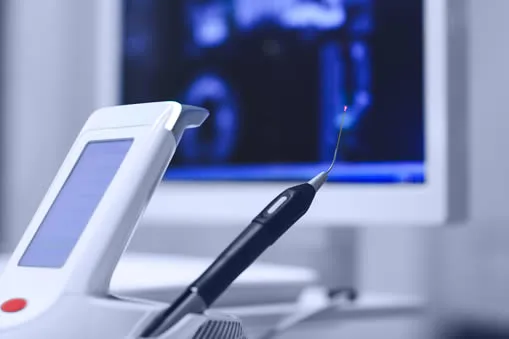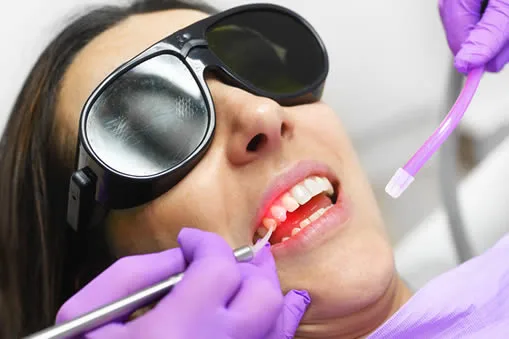Are you tired of the traditional dental drill and the uncomfortable buzzing and vibrations that come with it? If so, it’s time to discover the world of laser dentistry. Using advanced laser technology, dental procedures can now be performed with greater precision, less discomfort, and faster healing times. From filling cavities to treating gum disease, laser dentistry is revolutionizing the way we approach oral health. Say goodbye to the anxiety-inducing sounds of the drill and hello to a more comfortable and efficient dental experience with laser dentistry at our Tecumseh dental office.
What is laser dentistry?
Laser dentistry is a revolutionary treatment method that has transformed the dental industry in recent years. It uses specialized lasers to perform dental procedures with increased accuracy, less pain, and faster recovery times than traditional methods.
One of the most significant benefits of laser dentistry is its precision. Dental lasers can be used to target specific areas of the mouth, such as the gums, teeth, and tongue, with pinpoint accuracy. This allows for less tissue damage and a faster healing time.
Another benefit is that laser dentistry typically results in less pain and discomfort during and after treatment. The laser energy is precise and can cauterize tissue and reduce bleeding, swelling, and the need for anesthesia. This leads to faster recovery times and improved patient comfort.
Laser dentistry can be used for a wide range of dental procedures, including cavity removal, gum reshaping, teeth whitening, and even treating conditions such as sleep apnea and TMJ disorders.
Moreover, laser dentistry is considered safe when performed by a qualified dental professional. The laser used in dental procedures is highly concentrated, but it is also gentle and precise. Dentists who use lasers are trained to operate the technology safely and effectively.
Benefits of dental lasers
There are many benefits to using lasers in dentistry, including:
- Reduced Pain: Dental lasers can perform many procedures with minimal to no pain.
- Less Bleeding: Dental lasers can cauterize blood vessels as they cut, reducing bleeding during and after treatment.
- Minimal Swelling: Dental lasers cause less swelling and inflammation compared to traditional surgery.
- Faster Healing: With minimal swelling and bleeding, dental laser procedures often have faster healing times.
- More Precision: Lasers allow dentists to precisely target and remove damaged tissue while preserving healthy tissue.
- Reduced Need for Anesthesia: For some procedures, dental lasers can eliminate the need for anesthesia or the need for as much anesthesia.
- Fewer Infections: Lasers kill bacteria as they cut, reducing the risk of infection.
- Versatility: Dental lasers can be used for a wide range of procedures, making them a versatile tool in the dental practice.
- Improved Patient Comfort: Patients often report feeling more comfortable during and after dental laser procedures compared to traditional methods.
- Improved Accuracy: Dental lasers are highly accurate and can be used in hard-to-reach areas of the mouth.
More Questions about Laser Dentistry?
Contact our office today to schedule a consultation. We can answer any questions you have about laser dentistry procedures and address any issues unique to your specific situation. We look forward to seeing you.
How are lasers used in common dental procedures?
Lasers are used in various ways in dentistry, some of which include:
- Teeth Whitening: Lasers can be used to activate whitening agents in teeth bleaching procedures.
- Gum Disease Treatment: Lasers can be used to remove infected gum tissue and promote the regeneration of healthy tissue.
- Tooth Decay Removal: Lasers can be used to remove decayed portions of teeth and prepare them for fillings.
- Biopsies: Lasers can be used to perform soft tissue biopsies to diagnose oral diseases.
- Lesion Removal: Lasers can be used to remove lesions from the mouth, including canker sores and cold sores.
- Root Canal Treatment: Lasers can be used to clean and disinfect root canals.
- Reshaping Gums: Lasers can be used to reshape gums and improve the appearance of the smile.
- Tongue-Tie Treatment: Lasers can be used to release the tongue-tie, a condition where the tongue is tethered to the floor of the mouth.
- Implant Surgery: Lasers can be used in implant surgery to reduce bleeding and promote healing.
- Temporomandibular Joint (TMJ) Treatment: Lasers can be used to reduce inflammation and pain in the jaw joint.
These are some of the common ways lasers are used in dentistry, but the applications of lasers in dentistry are constantly evolving as technology advances.
Laser gum shaping
Laser gum shaping, also known as gum contouring or gingivectomy, is a dental procedure that uses specialized lasers to reshape and remove excess gum tissue. This procedure can be used to treat a range of issues, including gum disease, uneven gums, and excessive gum tissue.
The procedure is minimally invasive, and the use of laser technology allows for greater precision and less discomfort compared to traditional gum surgery. Dental lasers can target specific areas of the gum line, removing excess tissue without damaging healthy gum tissue.
Laser gum shaping typically involves less bleeding and a shorter recovery time than traditional gum surgery. It is also less invasive and less painful. Patients can usually return to their daily activities immediately following the procedure, and they can enjoy a more balanced and attractive smile.
If you are unhappy with your gum line, talk to our dentist about laser gum shaping to see if it is a suitable option for you.
ADDITIONAL FREQUENTLY ASKED QUESTIONS ABOUT LASER DENTISTRY
Can laser dentistry be used to treat cavities?
Yes, dental lasers can be used to remove decay and prepare the tooth for a filling.
Can dental lasers be used for cosmetic procedures?
Yes, dental lasers can be used for cosmetic procedures such as teeth whitening or reshaping the gums for a more aesthetically pleasing smile.
Are dental lasers safe for pregnant women?
While there is limited research on the safety of dental lasers during pregnancy, they are generally considered safe.
How long do dental laser procedures typically take?
Dental laser procedures can vary in length depending on the complexity of the procedure, but they are generally quicker than traditional methods.
Is there a dentist near me in Tecumseh that offers laser dentistry?
Yes. At our Tecumseh dental office we offer laser dentistry to patients from Tecumseh and the surrounding area. Contact our office today to schedule an appointment.
Helpful Related Links
- American Dental Association (ADA). Glossary of Dental Terms.
- American Academy of Cosmetic Dentistry® (AACD). Home Page.
- WebMD. WebMD’s Oral Care Guide.



